Note: This website was automatically translated, so some terms or nuances may not be completely accurate.
Creating "Teams That Keep Growing" ~ How Economics, Human Sciences, and AI Can Drive Productivity Improvement ~
Japan's labor productivity per worker ranks 32nd out of 38 OECD member countries, reflecting a long-term stagnation. This article focuses on digitalization and motivation as key drivers of productivity improvement, exploring insights for boosting productivity through "talent management" and "support for middle management."
We present a roundtable discussion featuring four experts: Professor Yosuke Yasuda of the National Graduate Institute for Policy Studies, specializing in microeconomic theory and market design; Michio Ochi, Executive Officer at HR tech company Midas; Nobuyuki Kaminaga, Chief Science Officer at Midas; and Rie Tanaka, Director of Dentsu Inc.'s Sustainability Consulting Office.
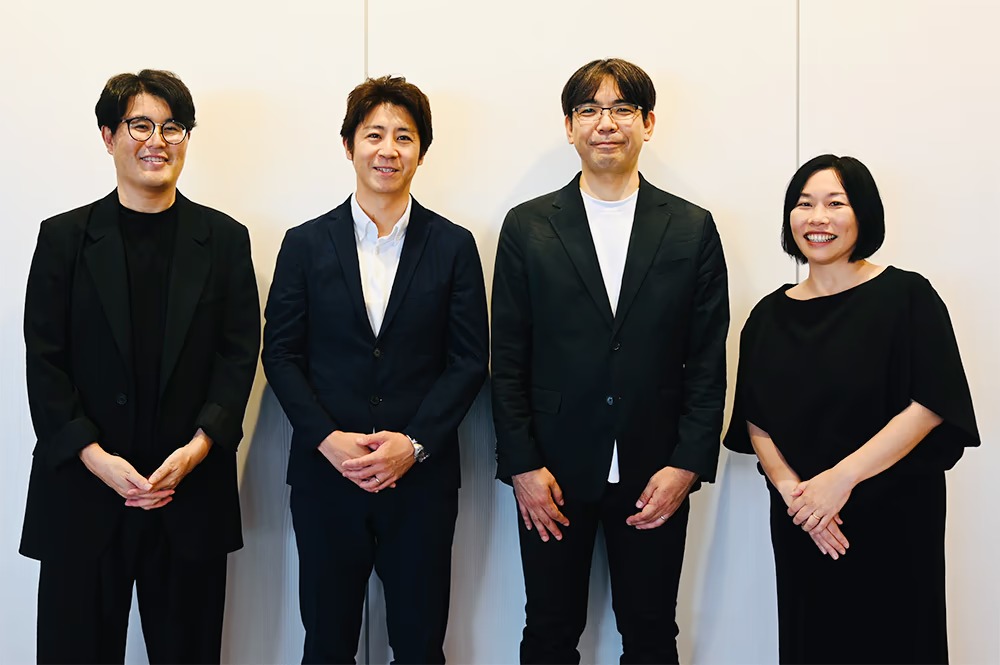
Midas
A direct recruiting service company within the PERSOL Group. Its signature feature is a flat-rate service that automatically sends scout messages to candidates deemed suitable for a company based on their skills, experience, and competency assessment results (diagnosing individual behavioral traits and thinking styles). Its recruitment branding service, which promotes applications from job seekers within the flat-rate fee, is also well-received.
Does reducing physical distance (D) through commuting increase organizational productivity (S)?
Tanaka: Today's theme is "How can we externally influence and promote team growth?" We want to explore methods for motivating people in business to grow teams and organizations, backed by data rather than abstract theories. First, Professor Yasuda, could you explain the "SDG Hypothesis" that will serve as our framework for this discussion?
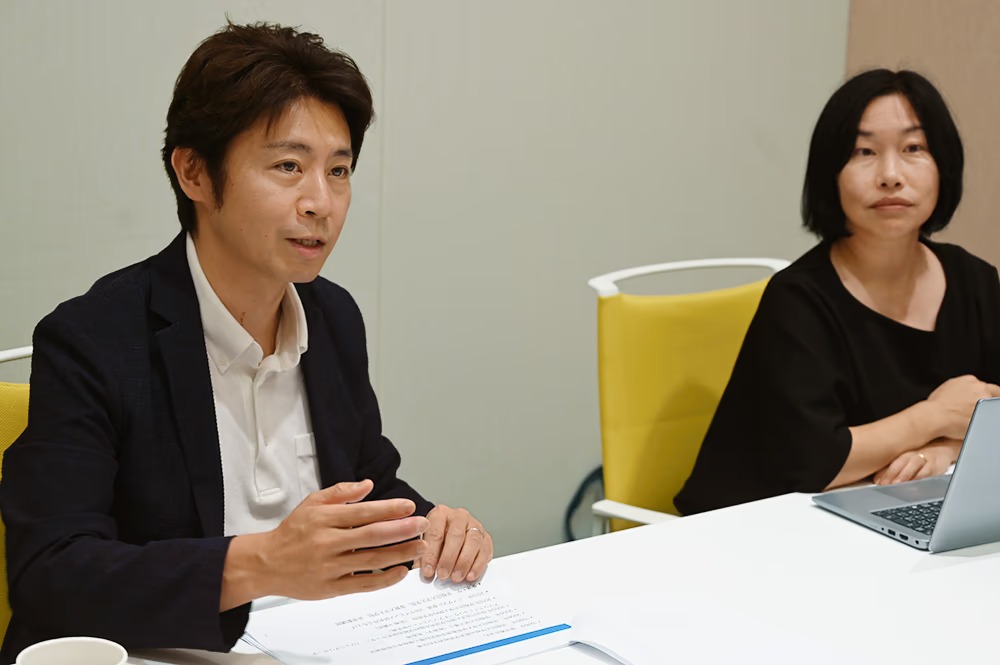
Yasuda: The S in the SDG Hypothesis stands for "Scale," representing quantitative evaluations and visualization measurable through skills, sales, etc. D stands for "Distance," a yardstick for gauging the relative closeness between people. We hypothesize that natural cooperative relationships form with those whose values and other aspects bring them closer. G stands for "Gravity," based on the idea that when both S and D are balanced and combined, they create an attractive gravitational pull, forming an appealing environment.
Broadly speaking, Japanese companies prioritized D, leading to increased homogeneity. Later, they incorporated the meritocratic S metric into personnel evaluations, yet productivity failed to rise. I believe organizations need to demonstrate the effectiveness of possessing both S and D—two fundamentally different metrics.
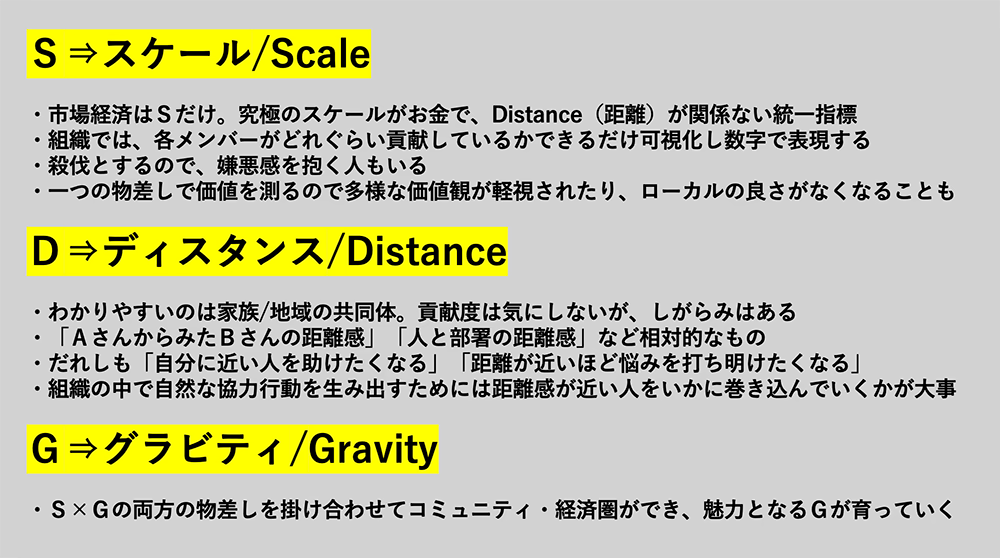
Tanaka: For employees, both D—related to workplace comfort—and S—related to business growth—contribute to a company's appeal. The recent increase in companies encouraging office attendance likely stems from the link between physical distance (D) and productivity/results (S). How to connect D to S is also a key focus in sustainability management.
Kaminaga: Actually, I was really looking forward to talking about this today, so I seriously studied and prepared materials.
Yasuda: Wow, really? It says "SDG Hypothesis Based on Miidas Assessment"! This is the first time I've seen materials using an SDG hypothesis created by someone else. I'm honored.

Teams where leaders expose their weaknesses have higher engagement and productivity
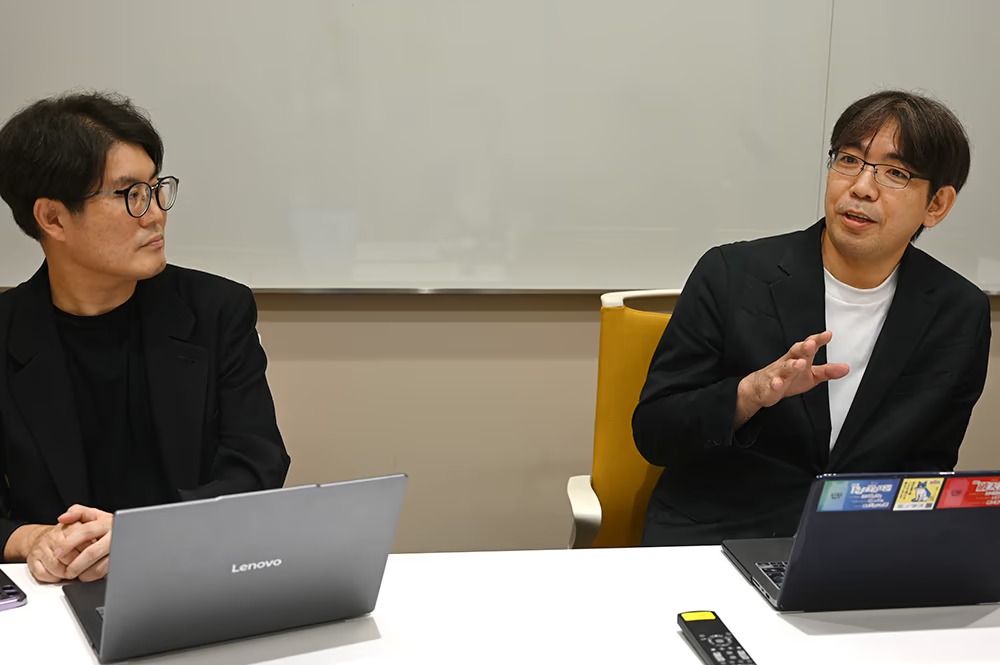
Kaminaga: "Data science takes time—from identifying trends in data, to verification, to implementation in products. If we could start with a hypothesis, couldn't we take a shortcut?" This idea from Midas's current president, Goto, led to the establishment of the Midas HR Science Institute in 2019. We conduct research by integrating information science—which handles AI and data science—with human sciences—which deal with theories and hypotheses from fields like psychology, economics, and linguistics.
Yasuda: Is the research approach different now at Midas compared to when you were conducting research at Waseda University?
Kamichō: The volume of data we can access is completely different from university research. Midas has contracts with 550,000 companies and can analyze status-specific data for approximately 1.5 million people through pre- and post-job-change surveys and organizational surveys.
Tanaka: The competency assessment, I believe, determines not only skills but also whether the job seeker's personality traits—including character—are a good fit with the target organization's culture and whether they are likely to thrive there, right?
Kamichō: Yes. The competency assessment evaluates 52 items on a 10-point scale, including personality, stress factors, and suitability as a manager or subordinate. We've also released a Bias Diagnosis Game service that identifies unconscious cognitive biases, enabling a total of 74 combined assessment items.
Ochi: With that many items, duplicate scores are virtually impossible. So we set three high-scoring items common to high performers valued within that organization. This allows us to automatically identify candidates likely to thrive in the workplace for the specific position being recruited.
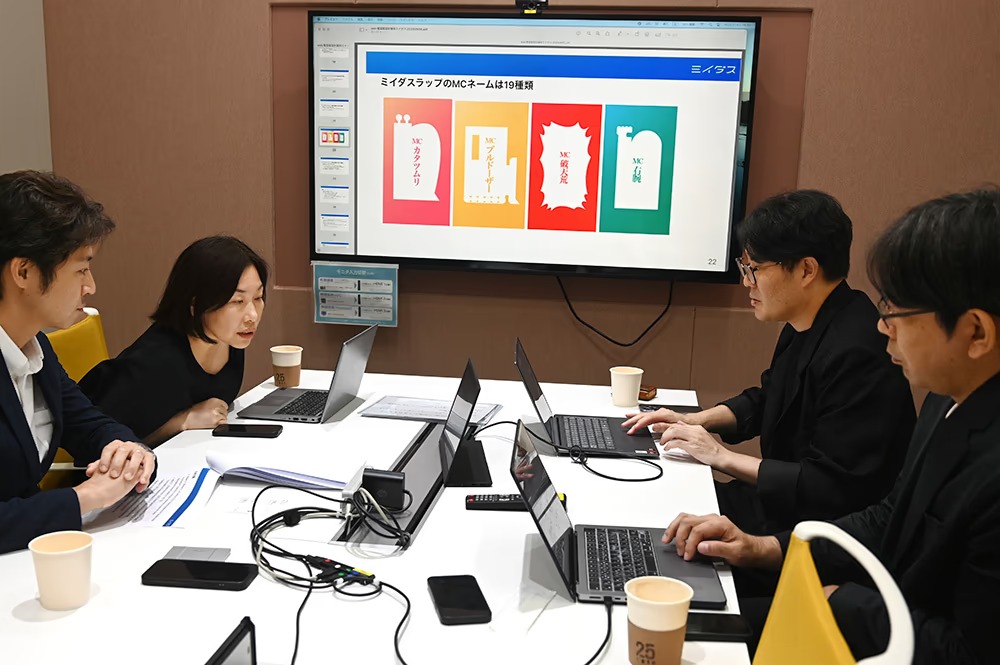
Tanaka: Deciding the top three attributes are important and managing their scores aligns closely with your expertise in brand management, doesn't it? Beyond job changes, would HR departments use this competency assessment for talent placement?
Ochi: Rather than HR using it discreetly behind the scenes, we actively recommend using it in a way that encourages "self-disclosure." When managers based on objective data revealed their weaknesses to their team members, those employees showed significantly higher engagement and productivity—often doubling their scores. Therefore, we suggest using the competency assessment to transform manager-subordinate 1-on-1s or to turn the results into turn the results into a rap for casual self-introductions.
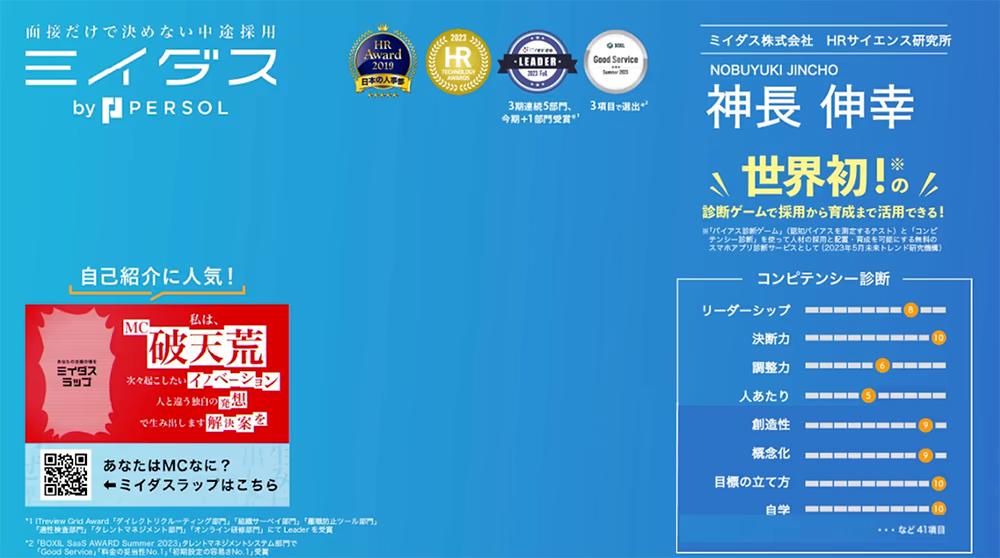
Yasuda: The idea of deliberately publishing it or turning it into a rap is interesting. The Midas Rap is surprisingly easy to accept, even though the latter part includes "doesn't value teamwork" and other critical points. Why did you choose to make it a rap in the first place?
Ochi: No one can realistically review 52 items of data for every team member, or even remember their own. So how should we share it? When we surveyed managers about when they'd prefer to reveal their weaknesses, responses included "during casual chats or drinks—we don't want it to feel too serious."
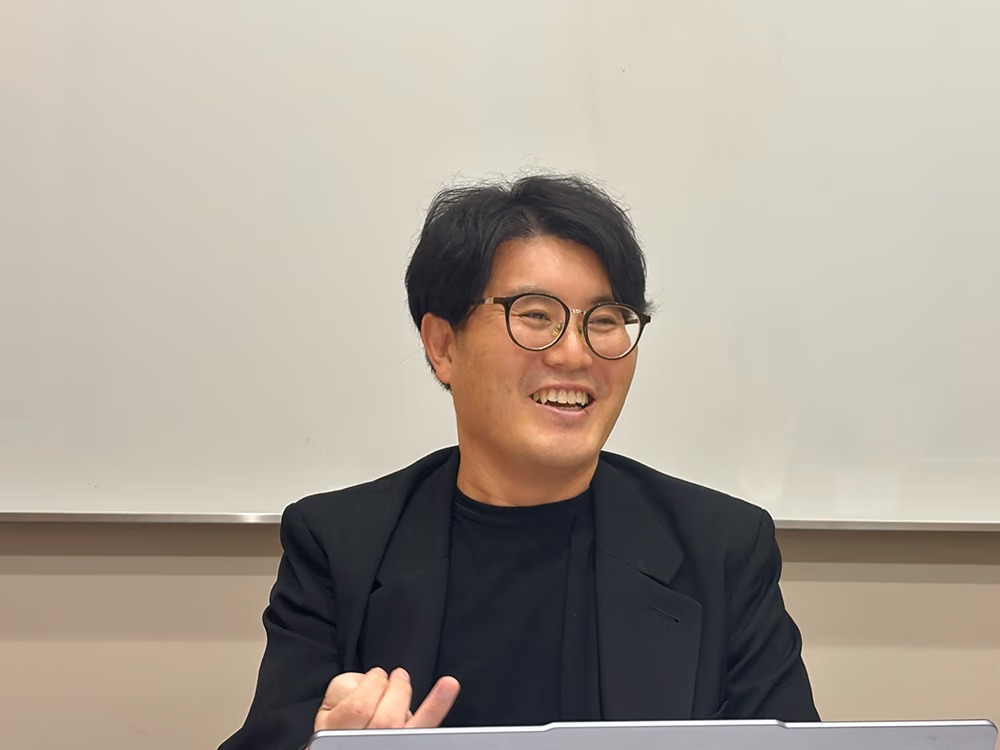
Kamichō: Scientific insights often seem intimidating, but we want companies to leverage these individual characteristics as much as possible. That's why we think the approachable rap format is excellent. Our HR Research Institute's mission is "to utilize scientific insights and reduce missed opportunities for success." As researchers, we want to track individuals' performance post-hire. From a research application perspective, we also want companies to actively use the competency diagnostics after hiring.
Ochi: We've expanded beyond direct recruiting to support companies post-hire through our data platform. For example, the "Worker First Award," co-hosted with Asahi Shimbun to recognize companies valuing their people, is now in its third year with 3,627 participating companies. This makes it Japan's second-largest award program by scale, second only to the Good Design Award's roughly 6,000 participants, contributing to enhanced corporate value and PR. Additionally, through the Miidas platform, we provide access to systems like employee benefits and e-learning—initiatives that small and medium-sized enterprises often struggle to implement but are highly valued by younger employees.
Tanaka: What's common across all these initiatives is the belief that "investing in people drives organizational growth."
The Balance Between Attraction Through Similarity and a Sense of Growth
Kaminaga: Research exists on the "similarity attraction hypothesis," which suggests we find people similar to ourselves attractive. Similarity elements include demographic similarity (gender, age, social status, etc.) and psychological similarity (personality, interests, emotions, etc.). According to the 2024 academic paper "Testing the Similarity Attraction Hypothesis in Employment Settings," demographic similarity influences hiring decisions and team formation, while psychological similarity tends to impact long-term teamwork.
Yasuda: Speaking of hiring, economics has a famous study on blind auditions for orchestras. Orchestras with higher social status tend to have more male musicians. When auditions were conducted with performers hidden to obscure their gender, more women were accepted. The author, Claudia Goldin, also made headlines for winning the 2023 Nobel Prize in Economics.
Kaminaga: That's precisely an example of "demographic similarity influencing hiring decisions." In this case, I think relying solely on similarity led to negative consequences.
Yasuda: If you only use the D-axis, which is highly homogeneous and male-dominated, you risk rejecting highly capable women based on the S-axis of actual ability. Conversely, if you select members purely based on the S-axis under a strict meritocracy, there's a risk the organization could become one where only the top 20% thrive, following the Pareto principle (which states that 80% of sales depend on 20% of employees). There are very few jobs in companies that can be done entirely alone; the premise is that teams work together. I believe it's crucial to have indicators for "people likely to thrive in this organization" based on both S and D elements, similar to competency assessments.
Tanaka: People who are similar to our existing members—those who "fit our company"—will likely work well in teams and be easier to evaluate. But if everyone is too similar in both S and D, doesn't that lead to a lack of diversity and make us vulnerable to change?
Yasuda: I don't think everyone needs to be equally close. In organizations where interpersonal distances aren't visible, shared factors like alma mater, hometown, hobbies, or beliefs create clusters of closely connected individuals. People who are close interact even across departments, sharing information about their work despite different responsibilities and building cooperative relationships when needed.
Having multiple D-dimensions creates clusters of people, fostering cooperative behavior. At the same time, different clusters form, allowing competition between groups to function appropriately. I believe organizations with this kind of D can cooperate more effectively than those without defined D-dimensions or mechanisms.
Tanaka: I see... Unlike S, which focuses on superiority and inferiority, D doesn't have just one axis. I used to think tech companies deliberately promote cultural events like mountain climbing to bridge the gap between individuals and the company. But perhaps these events actually spark several clusters of mutual cooperation, which then positively impacts productivity. Gallup's employee engagement survey "Q12®" (※1) also includes "Having a best friend at work" as a key question.
※1=Gallup's Employee Engagement Survey "Q12®"
A 12-question survey measuring work enthusiasm and immersion, also called work engagement, to gain insights for improving corporate performance
Kaminaga: Researcher Fred Lousans proposed the concept of "psychological capital" as part of human capital. This refers to psychological traits measured and developed to improve job performance, comprising four elements: "self-efficacy," "hope," "resilience," and "optimism." These are psychological perspectives on factors that boost productivity, considered unique to the field of organizational behavior and capable of development and change. We believe many items in Midas' competency assessment align with Lussac's definition of psychological capital.
Yasuda: We often hear about "self-esteem," but is "self-efficacy" different from that?
Kaminaga: Thinking "I can do anything" relates to self-esteem or a sense of competence. Self-efficacy, however, is task-specific. For example, consider someone who is good at math but not English. If they think, "I could be useful in this job that only uses math," that's self-efficacy.
Yasuda: I see. So feeling capable of anything is self-esteem, while considering specific ways you can be useful is self-efficacy!
Kamichō: Finally, if the charm of a place, G, doesn't come from individuals but from relationships, then it's probably close to social capital. People's relationships include cohesive networks based on similarity and bridging networks based on dissimilarity (※2). Bridging networks have weaker cohesion but are open, allowing various resources to flow in, making it easier to acquire new information.
※2 = Bridging Networks
Refers to broad, shallow human relationships or networks between organizations. Contrasted with homogeneous "bonding networks," these connect diverse people and different expertise, aiding knowledge transfer and innovation.
(Adler & Kwon, 2002; Hattori, 2020; Putnam, 1995)
Tanaka: Bridging networks seem like a useful hint. In my department, which is close to being a professional field, some people in their 30s and 40s say, "It's comfortable, I can work autonomously, it's rewarding, and I have no complaints. But it's hard to feel like I'm growing." Even if it's easy to work, if there's no sense of growth, engagement with the organization declines.
Kaminaga: I also hypothesize that when people unsatisfied with similarity networks create bridging networks, allowing both to coexist, productivity improves. This is a topic I'd like to explore empirically in future research.
Tanaka: As seen in the 1on1 video below, where middle management realized, "We treated the designer as a specialist, but they actually wanted to be a leader," it's great to have mechanisms that let people find new growth paths without needing transfers.
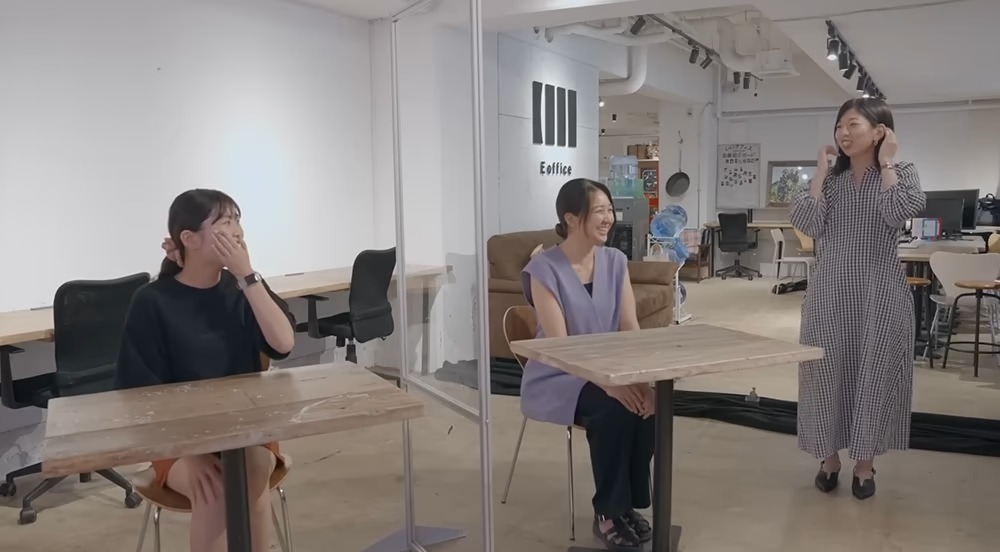
※Click the image to watch the video
Yasuda: Actually, maybe replacing the "G" in SDG with "Growth" might make more sense. Beyond just the snapshot-like S and D capturing a specific point in time, I feel that the employee's perspective on whether they can grow going forward is a crucial metric. The expectation that "if I hone this skill in this department, I'll likely have a high chance of growth" seems like it could be a powerful motivator.
Tanaka: If the term "growth" carries strong expectations of "unlocking hidden potential" or "fixation on a specific position," it becomes exhausting when it feels beyond the individual's control. In that case, aiming for team growth is less stressful and fosters a sense of contribution. Personally, I think it would be good if members outside management could also feel ownership, like "I'm contributing to the growth of the team and organization."
Ochi: The bottleneck for HR is the lack of benchmark data from competitors—we only have our own company's data. We need industry-standard metrics and scales. And we must approach this from both sides: not just the responsibilities of managers, but also what the roles and obligations of subordinates are. We want to move towards evaluating followership just as we evaluate leadership.
Kamichō: Mechanisms to measure hidden qualities and followership, and track individual growth, are becoming available. We want to consider situations where middle management can utilize these and implement them.
Tanaka: While there's still much to discuss, today we've heard insightful perspectives from various angles on actions we can take to improve productivity. Thank you very much.
The information published at this time is as follows.
Was this article helpful?
Newsletter registration is here
We select and publish important news every day
For inquiries about this article
Back Numbers
Author

Yosuke Yasuda
政策研究大学院大学
Professor
Born in Tokyo in 1980. Graduated from the University of Tokyo in 2002. Received the Ouchi Hyoe Award for the best undergraduate thesis and served as the graduate representative for the Faculty of Economics. Studied at Princeton University, USA, earning a Ph.D. in Economics in 2007. After positions including Associate Professor at Osaka University, assumed current position in October 2025.Specializes in game theory and market design. Published numerous papers in international economics journals, including the American Economic Review. Also serves as a government committee member and television commentator. Co-founded Economics Design Inc. in 2020 to "apply economics to business." Major publications (co-authored) include "Is Japan's Future Really Okay? Conference" (Nihon Jitsugyo Publishing, 2024).

Michio Ochi
Midas Inc.
Executive Officer, CMO
After 13 years in marketing at L'Oréal, he served as Senior Brand Manager for LUX at Unilever and then as Global HQ Brand Manager at Shiseido. After nearly 20 years in the consumer goods and cosmetics industries, he oversaw marketing for both Lenovo and NEC at Lenovo Japan. He currently serves as Executive Officer and CMO at HR tech company Midas. He also acts as a Professional Advisor for the Faculty of Economics at Shiga University.

Nobuyuki Kaminaga
Midas Inc.
HR Science Institute
Director
Born in Tokyo in 1976. After graduating from Waseda University's School of Political Science and Economics with a major in Economics, he pursued psychology and entered the same university's School of Education as a bachelor's student. He then advanced to the graduate school, where he completed coursework before withdrawing. He subsequently conducted research on language development processes at the RIKEN Brain Science Institute. In 2015, he joined Waseda University's School of Human Sciences as an assistant professor. Alongside language development research, he began studying communication within virtual reality spaces. He has held his current position since April 2019. As Director of the HR Science Institute, he leads research targeting the human resources industry, aiming to integrate human sciences with data science, and oversees the product implementation of these research outcomes. As a researcher in human sciences, he is also engaged in developing measurement methods for psychological traits that can predict workplace performance. Alongside his corporate research, he serves as a lecturer teaching subjects such as psychology and people analytics at Waseda University Graduate School, Toyo University, and Shiga University.

Rie Tanaka
Dentsu Inc.
Sustainability Consulting Office
Director
Assumed current position in 2023. Responsible for talent development and organizational development within the organization, as well as sustainability branding, global research, and circular economy business promotion. After working at a telecommunications company, joined Dentsu Inc. and established multiple labs as a principal researcher in consumer behavior studies. Subsequently, helped launch Dentsu Digital Inc. and was seconded for two and a half years to the data science department of a consumer goods manufacturer to drive DX. After returning to Dentsu Inc., he worked in global business for two and a half years and was seconded to establish the Dentsu Group Sustainability Promotion Office in 2022, and was involved in establishing his current department the following year. Executive Coordinator, Organization for Advanced Science and Social Innovation, Kanazawa University Certified NPO Service Grant Partner Certified facilitator of LEGO®SERIOUS PLAY® method and materials


